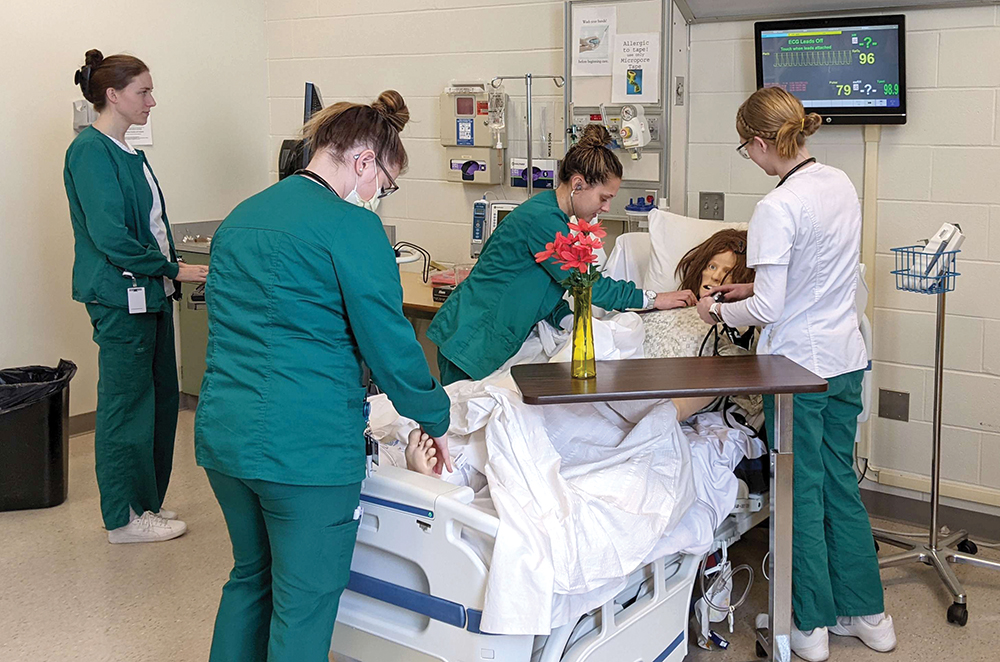 Students attend to a mannequin patient in the nursing simulation lab at Manchester Community College. (Judi Currie)
Students attend to a mannequin patient in the nursing simulation lab at Manchester Community College. (Judi Currie)
The pivot to online education during the pandemic accelerated technology transformations at colleges and universities, and redefining how education is delivered. Two years into the pandemic, most schools now offer multiple ways for students to access their education.
Advancing the hybrid classroom forced colleges and universities to adopt new technology and retrain faculty and staff, says Dr. Donald L. Birx, president of Plymouth State University. “It drove us to take a step that would have taken longer because we were suddenly thrown into the deep end,” he says. “We have made education more available, versatile, efficient and effective.”
White Mountains Community College in Berlin ended up implementing its 10-year tech plan in one year because of COVID.
“From a technology standpoint we are set for the foreseeable future,” says Charles Lloyd, the college’s president.
Sister Paula Marie Buley, president of Rivier University in Nashua, says they have been building a foundation for remote learning for years with a management system that’s engaging and interactive. “Our faculty have been working with the technology for seven to eight years, so they were well-prepared,” she says. “What I do see is greater sophistication in simulations and virtual reality. The next step is artificial intelligence. Now you are interacting with a system that is learning from you and changes its responses based on what it has learned from you.”
The pandemic has inspired colleges and universities to leverage technology to meet the immediate needs for NH’s workforce, such as health care and cyber security but also to build the workforce of the future.
Responding to Crisis
Rivier University opened a $5 million Nursing and Clinical Innovation Center in March that uses simulations to immerse students in clinical scenarios. The center includes six simulation labs that mirror the settings in which nurses most often provide care: medical/surgical and pediatric/neonatal hospital rooms, an obstetrics room, examination rooms and telemedicine offices. “Nurses are so much more involved with technology,” says Buley. “We must ensure that students are workplace ready.”
Manchester Community College (MCC) uses high-tech mannequins to train nursing students, says Jill Reid, professor of nursing who runs the college’s nursing simulation labs. She says training mannequins have become far more sophisticated and can be controlled by a computer or tablet to respond to the students’ actions and to simulate possible reactions a patient might have that the students must then address.
One simulation might involve a patient who is hypoglycemic, while another involves an opioid overdose requiring the student to administer Narcan. Reid controls the action in a control room behind a two-way mirror. “As they’re taking care of the patient, I can talk for it, respond to their actions and change the vital signs,” says Reid.
The MCC nursing program also received a BD Pyxis Medication dispenser, identical to those used in hospitals, to train students on equipment they’ll be using in the field.
When the pandemic threatened the ability of Southern NH University students in nursing and health care to graduate on time as they did not have a way to do internships or practicums, the school adapted an existing experiential learning model launched in 2018 called HEaRT (Higher Education and Real-world Training) to allow them to complete a virtual practicum.
“Even before COVID we saw a need for an online environment in which students could do things that were difficult in a traditional online delivery mechanism,” says Jan Wyatt, associate vice president of Nursing, Health Professions, STEM and Business. “It was important that students be able to apply critical thinking skills to solve real world problems, working within teams, and not based on a case study or in a contrived way. The design also needed to support networking and resume-
building skills.”
Dr. Toni Clayton, executive director health professions at SNHU, says HEaRT connects students with employers who provide them with problems to solve. “The employers tell us they have implemented many of the suggestions students make. Many have issues they’re trying to solve but don’t have the staff to work on them, and they’re happy to let the students,” Clayton says.
Adds Wyatt, “We give them badges for it, and the badges can aggregate into credit for a much lower cost or work toward micro credentials.”
Cybersecurity
From national elections to a larger segment of the workforce working remotely, cybersecurity has become a hot topic and demand for workers in that field continues to grow. The new cybersecurity lab at Rivier University is highly interactive, teaching students about ethical hacking and real-time threat assessments and training them on the latest software. It allows students the chance to solve real problems using real technology. “Cyber threats are ubiquitous, so no matter what industry they go to, they will have a level of comfort with the technology, with the processes and the outcomes,” Buley says.
MCC uses a similar approach in its cybersecurity classroom, which recently instituted virtual and augmented learning technology as well as fully immersive headsets (in addition to standard PCs) to access “hands-on” lab work without needing to physically be in the classroom, says Peter La Monica, chair of the MCC Computer Science Department.
“We start from the ground up. We need them to know how it all works before they can tell me how someone broke into the system,” he says.
This semester students are working on a project focused on Li-Fi, a wireless technology that uses light to transmit data. “It puts out radio waves creating an ultra-secure communication channel. If we close these blinds, it cannot be seen outside the building the way a Wi-Fi network can,” La Monica says. “Last semester, students designed it, this semester students will install it.” Li-Fi, La Monica explains, can be deployed by retailers to broadcast messages to shoppers.
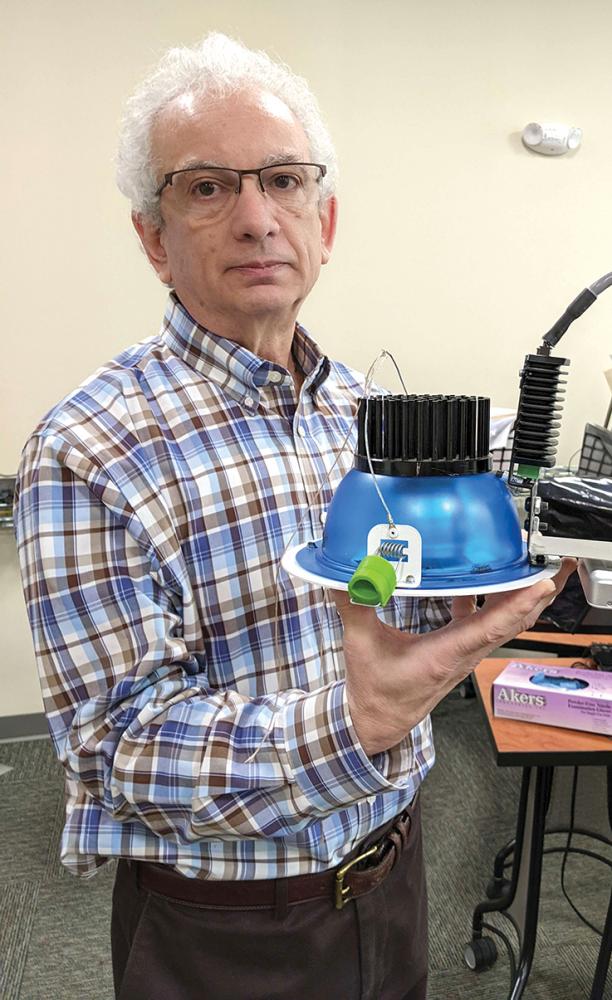
Peter La Monica, chair of the MCC Computer Science Department demonstrates Li-Fi, a special light that uses radio waves for ultra-secure communication. (Judi Currie)
Training Game Designers
The video game market just keeps growing and benefited from people being stuck at home during the pandemic. In 2021, the games market generated an estimated $180.3 billion in revenue, according to Newzoo.
As such, NH colleges and universities have developed programs for that industry. Plymouth State University launched a new game design major and has an esports club while the University of NH offers courses in game development. Plymouth State University’s game design major allows students to focus on either creative media or technology to prepare them for such jobs as game designers, interactive web developers and digital artists.
Southern NH University offers a BA in game art and development and a BS in game programming and development. The University’s Inkwell Interactive Studio replicates a typical game design studio with high-performance PCs, large wall-mounted monitors and virtual reality (VR) spaces.
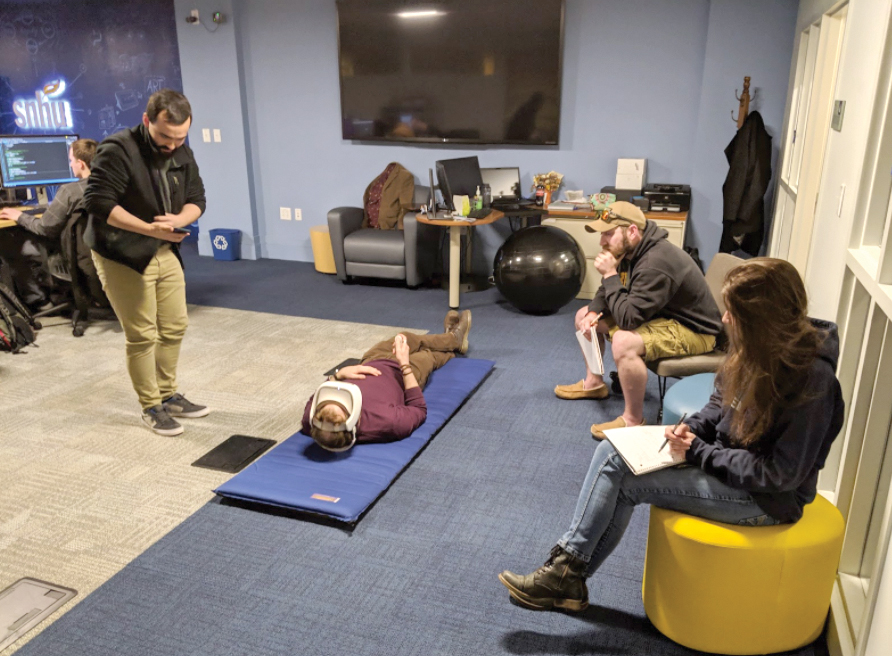
SNHU students in the Inkwell Interactive Studio. (Courtesy of SNHU)
Game designer and instructor Ed Brillant says Inkwell allows students to gain skills outside the classroom through projects driven by students, faculty and administration. One of the first COVID-era projects was a virtual reality campus tour for the SNHU marketing department.
Brillant says the program takes a more experiential approach to the classroom. “Instead of a two-hour lecture, I have a series of videos that might be two to 10 minutes long. Students watch these for homework then in class, there is more time to work on projects, and I get to know my students better,” he says.
Advanced Manufacturing
Manchester Community College is keeping pace with the advanced needs of manufacturers by teaching students computer aided design, 3D printing and bioprinting, says Dan Larochelle, advanced manufacturing technology chair at the college.
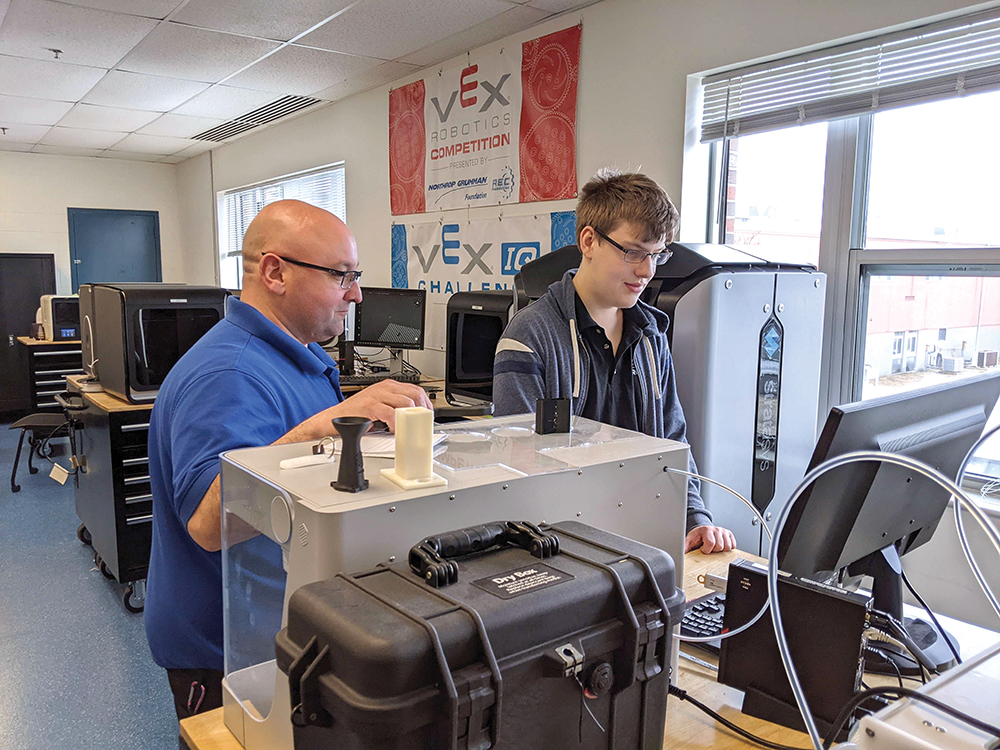
Dan Larochelle, Advanced Manufacturing Technology chair at Manchester Community College and Eann McCurdy, AMT student, work on a 3D printing project. (Judi Currie)
Larochelle uses augmented virtual reality in his lessons so students can view and explore expensive parts and devices not available in the classroom.
Nashua Community College is known for its engineering and manufacturing programs and has developed a strong relationship with the state’s largest manufacturing employer, BAE systems in Nashua, one of many local manufacturers that provide access to the latest equipment, says college President Lucille Jordan. “We are always current in terms of the equipment we have because the companies want us to use it in the classroom so the students will have that experience,” she says.
Growing NH’s Biotech Workforce
Inventor Dean Kamen, president of DEKA Research & Development Corp., wants to develop Manchester into a hub for biomanufacturing—a place where, eventually, human organs can be developed in labs. As such, UNH Manchester has become an integral part of the budding bio-fabrication ecosystem in Manchester, says the university’s dean, Michael Decelle. UNH Manchester offers degree programs aimed at training students for the bio-fabrication field. He adds the university is working closely with Kamen, who is executive director of the Advanced Regenerative Manufacturing Institute (ARMI).
“We are trying to make Manchester the place where fabrication of tissues and organs takes root and becomes the center of that industry,” says Decelle. “Successful industries of this type are often nearby or co-located with a research university, where we provide the research and the workforce supports.”
Since ARMI was formed in 2016 after being awarded the biofabrication contract from the U.S. Department of Defense, UNH Manchester has invested in infrastructure and programs to support ARMI’s efforts. In 2019, it launched the Millyard Scholars program, which provides scholarships and research opportunities to high-achieving students interested in biotechnology.
Tech Transforms Classrooms
New Hampshire’s colleges and universities have made a variety of investments in technology that are transforming the way students learn.
Rivier University has infused technology into the classrooms of its new Science and Innovation Center, including electron microscopes that were once only available to the most sophisticated scientists and institutions. Through online and asynchronous learning, Rivier has brought doctoral degrees into the living rooms of students, says Buley. “Professionals who are already adept at nursing or business, mental health [and] behavioral health who wish to pursue the next level of credential can do it from home. That’s especially nice in New England. They can avoid the wear and tear of traveling, particularly during the winter months,” she says.
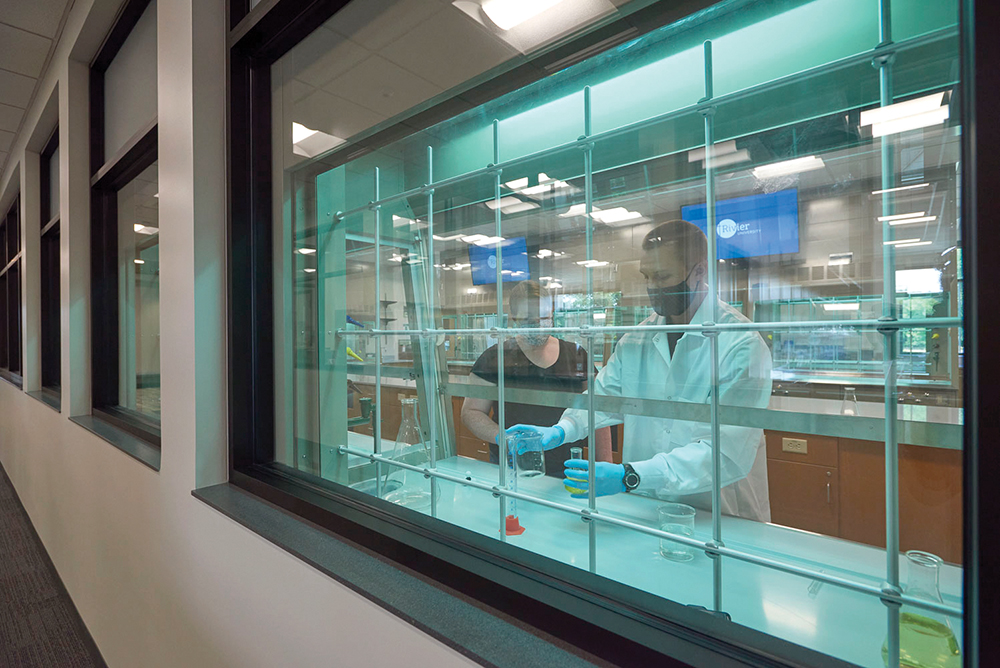
The River University Science and Innovation Center. (Courtesy of Rivier University)
At Nashua Community College, diagnostic tools used throughout its automotive programs have changed the curriculum, Jordan says. “Electronics is now a gateway course for all of our automotive students, whether they are going into collision repair or auto technology,” she says. “We have the only auto collision repair program in the state, and students never had to understand the electronic piece in the past. But it’s not just putting on a new door now. You have to know how to handle the electronics built into it.”
White Mountains Community College uses simulations for a variety of courses, including welding, something Lloyd would not have thought possible before COVID. “We’ve been doing online since 1990, before it was cool. But the offerings have become more robust,” he says.
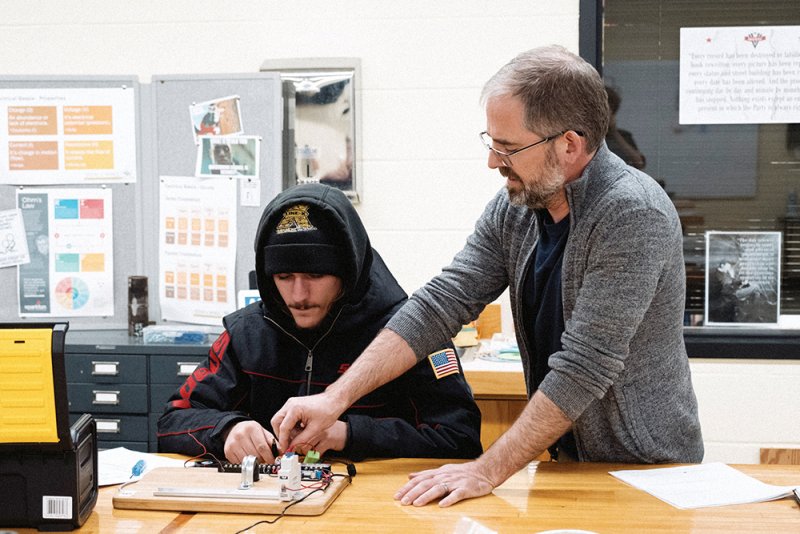
White Mountains Community College student Brandon Richards, left and STEM and Advanced Manufacturing professor John Holt, build a voltage divider circuit. (Courtesy photo)
State Schools Create More Efficient IT
When the pandemic began, IT departments among the schools that make up the University System of NH (USNH) were in the process of consolidating to a single department, says William Poirier, UNH Chief Information Officer. (USNH includes the University of NH in Durham, University of NH School of Law in Concord, University of NH at Manchester, Plymouth State University, Keene State College, and Granite State College in Concord.)
Each institution had autonomy, resulting in disparate technology. “University System leadership saw the cost savings potential and we are extremely lucky that we were in the process when [the pandemic] occurred,” says Poirier.
When NH’s institutions shifted online, they did so at breakneck speed, Poirier says, but for fall they had to be ready to support remote and hybrid. “We had to outfit 193 classrooms between May and August of 2020. It was not just equipment but professional development for hundreds of faculty members at our six institutions. It was 105 days of acts and miracles,” he says.
The new connectedness of the USNH system means greater access for all students. “It gives you the ability to work across the system where a class offered at UNH can be taken at Plymouth State University and vice versa,” says Donald L. Birx, president of Plymouth State University.
The Community College System of NH also benefits from a centralized IT system, says Dr. Mark Rubinstein, chancellor. There are seven colleges and 12 instructional locations across the state, which share a common infrastructure for student information systems, software licensing for technology platforms and shared resources for managing that technology.
“It is a significant change,” Rubinstein says. “When I went to college we went to the library, looked in the card catalog and dug out the material from the stack. There was often only one copy and if it wasn’t there, it wasn’t there. Now, with so much available in digital collections, we are supporting students with instructional material literally from across the globe.”

 Current Issue - April 2024
Current Issue - April 2024